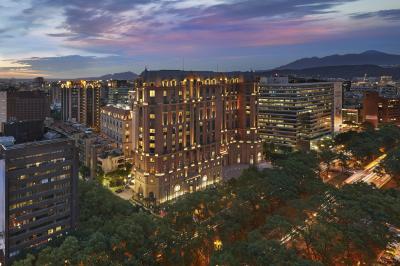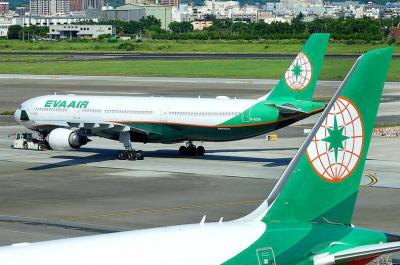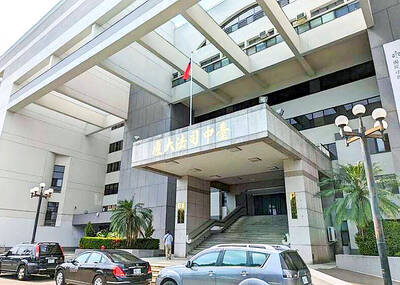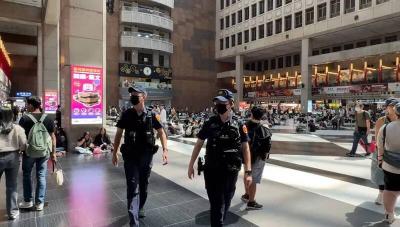Taiwan Semiconductor Manufacturing Co (TSMC) chief executive officer C.C. Wei (魏哲家) smiled broadly as he stood next to US President Donald Trump in the White House on Monday, announcing what he said was the biggest foreign direct investment on US soil in history. His company — the producer of most of the world’s most advanced semiconductors — would boost its existing US$65 billion US presence by US$100 billion.
For TSMC, the deal meant they would avoid massive tariffs Trump had flagged for the global chip industry.
For the US, it means tens of thousands of construction jobs, and the eventual development of crucial technology on US soil, far away from the threat of China taking control of it if it one day annexed Taiwan.

Photo: Eason Lam, REUTERS
The deal is not set in stone. Under Taiwanese law, TSMC is required to have government approval for any foreign investment of more than US$1.5 billion — a fraction of this deal’s size.
President William Lai (賴清德) said the government would review the deal with national interests in mind. The Ministry of Economic Affairs on Wednesday said it had not received an application yet.
However, the deal has rung alarm bells. Members of the opposition Chinese Nationalist Party (KMT) have said it could weaken Taiwan’s security.
“The more TSMC produces in the US, the lower Taiwan’s geopolitical importance will be, and the less incentive the US will have to help Taiwan,” KMT Legislator Ko Ju-chun (葛如鈞) said.
Taiwan’s chip industry is seen by many as the nation’s “silicon shield,” a significant piece of leverage to incentivize the world to help keep it — and the globally crucial chip supply — out of Chinese hands.
Lai’s office said it would ensure that TSMC “will keep its most advanced manufacturing processes in Taiwan,” but that statement appeared at odds with what Wei and Trump said at the White House.
Wei reportedly said the deal meant TSMC would be “producing the most advanced chip on US soil,” while Trump declared: “The most powerful AI chips in the world will be made right here in America.”
Asked to define the “most advanced tech” that the government was pledging to keep onshore, given that TSMC’s most advanced product — its 2-nanometer chips — are already scheduled for US production, the ministry appeared to suggest it was human talent.
It described Taiwan’s science, technology, engineering and math training-to-employment pipeline that underpins the local chip industry’s success.
“This is highly dependent on Taiwan’s high-quality semiconductor talents, an advantage that is difficult for other countries to replicate,” the ministry said.
National Chengchi University diplomacy professor Huang Kwei-bo (黃奎博) said the Lai administration needs to heed people’s “rising worry” about the weakening silicon shield.
Lai and Wei held a news conference on Thursday, where Wei said that he had a “stressful” few days meeting two presidents, and suggested that Lai had ordered him to face the press, because they “must explain this to the public.”
Lai said the deal was a “historic moment” in Taiwan-US relations. He and Wei provided assurances that the investment would not dilute or hinder the domestic business of TSMC. Both insisted that there was no political pressure from the US, and that it was due simply to increased customer demand from the US. They did not mention tariffs or answer concerns about the security of the silicon shield.
Huang said it was “reasonable and honest” for Wei to say the expansion was driven by customer demand.
Tariffs and restrictions on China buying critical chips mean that TSMC’s revenue now overwhelmingly comes from the US.
“What has remained very vague is the Taiwan government’s attitude and policies,” he said. “The Lai administration should be clear to the Taiwan public both about the potential economic and psychological effect TSMC’s recent decision will cause.”

The first global hotel Keys Selection by the Michelin Guide includes four hotels in Taiwan, Michelin announced yesterday. All four received the “Michelin One Key,” indicating guests are to experience a “very special stay” at any of the locations as the establishments are “a true gem with personality. Service always goes the extra mile, and the hotel provides much more than others in its price range.” Of the four hotels, three are located in Taipei and one in Taichung. In Taipei, the One Key accolades were awarded to the Capella Taipei, Kimpton Da An Taipei and Mandarin Oriental Taipei. Capella Taipei was described by

EVA Airways today confirmed the death of a flight attendant on Saturday upon their return to Taiwan and said an internal investigation has been launched, as criticism mounted over a social media post accusing the airline of failing to offer sufficient employee protections. According to the post, the flight attendant complained of feeling sick on board a flight, but was unable to take sick leave or access medical care. The crew member allegedly did not receive assistance from the chief purser, who failed to heed their requests for medical attention or call an ambulance once the flight landed, the post said. As sick

The Taichung District Court yesterday confirmed its final ruling that the marriage between teenage heir Lai (賴) and a man surnamed Hsia (夏) was legally invalid, preventing Hsia from inheriting Lai’s NT$500 million (US$16.37 million) estate. The court confirmed that Hsia chose not to appeal the civil judgement after the court handed down its ruling in June, making the decision final. In the June ruling, the court said that Lai, 18, and Hsia, 26, showed “no mutual admiration before the marriage” and that their interactions were “distant and unfamiliar.” The judge concluded that the couple lacked the “true intention of

A drunk woman was sexually assaulted inside a crowded concourse of Taipei Railway Station on Thursday last week before a foreign tourist notified police, leading to calls for better education on bystander intervention and review of security infrastructure. The man, surnamed Chiu (邱), was taken into custody on charges of sexual assault, taking advantage of the woman’s condition and public indecency. Police discovered that Chiu was a fugitive with prior convictions for vehicle theft. He has been taken into custody and is to complete his unserved six-month sentence, police said. On Thursday last week, Chiu was seen wearing a white